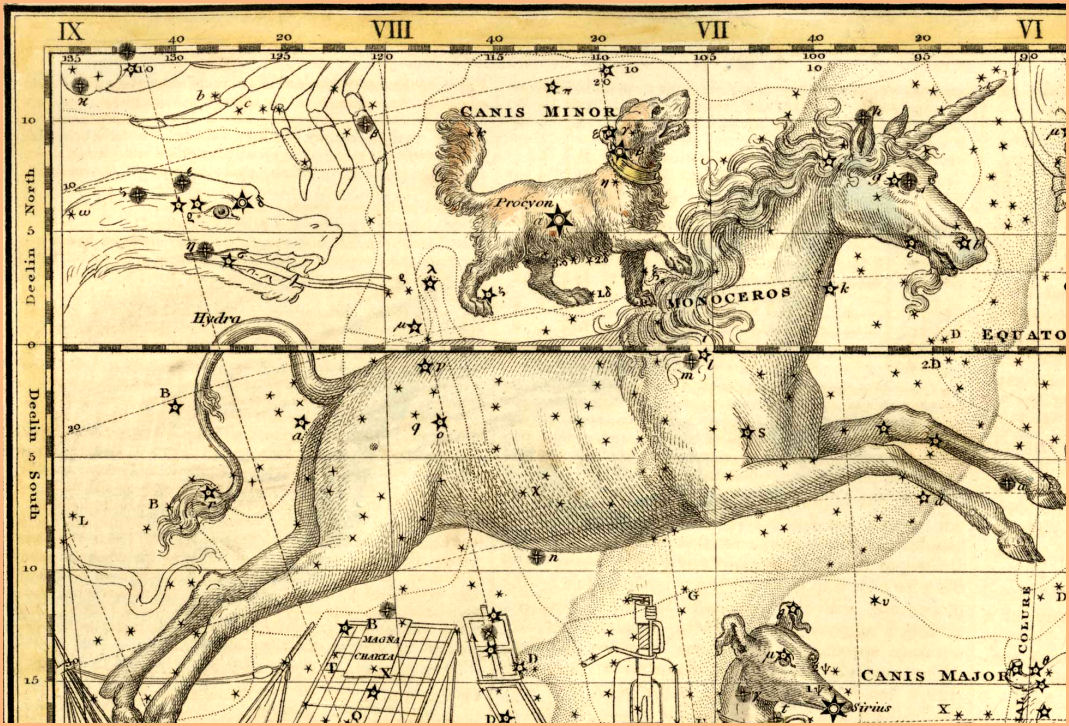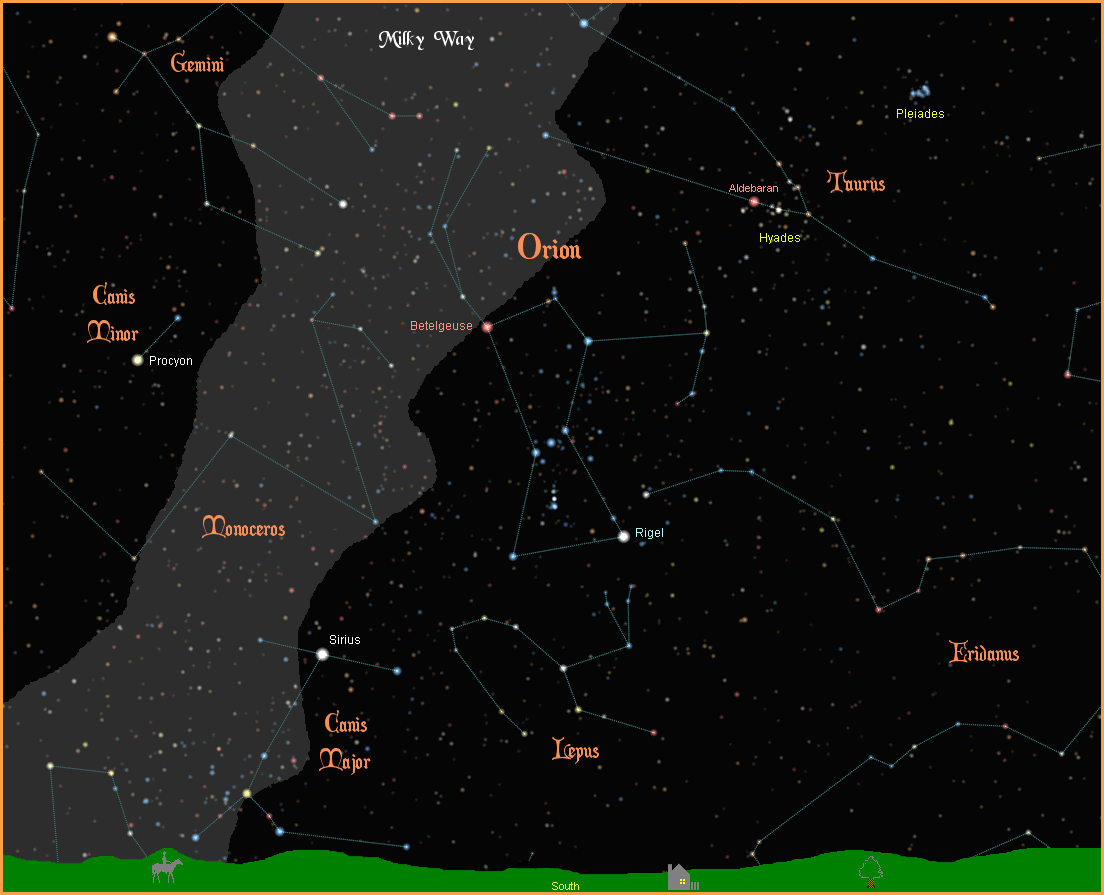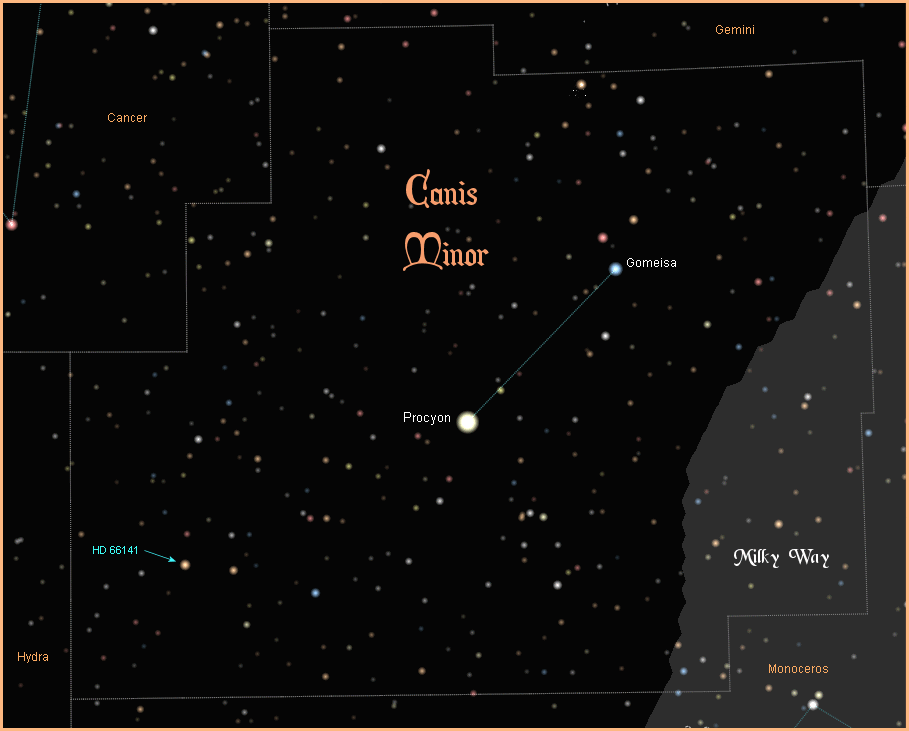| HOME |
|---|
CANIS MINOR
The Little Dog

Canis Minor - Celestial Atlas by Alexander Jamieson - 1822
| HOME |
|---|

Just across the Milky Way from Canis Major, leaping at his master's shoulder like a young pup, is Canis Minor, the little dog, traditionally thought of as the smaller of Orion's two faithful hunting dogs. It's one of the smallest constellations in the sky, and has little to offer deep sky observers, but it does provide a home to one of the closest and brightest stars in the sky - Procyon.

Alpha Canis Minoris is the brilliant Procyon. The name is Latin for before the dog, as it rises in the east just before Sirius, the great Dog Star. Procyon itself is no slouch however, with a magnitude of 0.35 it is the eighth brightest star in the sky. Like its big brother Sirius, its brightness is very much a result of its closeness, only 11.3 light years away, making it the fifth closest naked eye star to Earth, and the fourteenth closest overall.
Also like Sirius, Procyon is a binary system. The primary star, designated Procyon A, is an F5IV yellow/white subgiant twice the size of our Sun, and six times brighter, with a surface temperature of 6,530 degrees K. The companion star, Procyon B, is a small white dwarf with a magnitude of 10.82. It takes 40.8 years to complete one orbit around Procyon A, coming as close 827 million miles (8.9 AU), and retreating back out to a distance of 1.95 billion miles (21 AU). The powerful gravity of this close white dwarf would most likely prevent any possible planets from forming stable orbits, and greatly inhibit the evolution of life.
Along with Betelgeuse and Sirius, Procyon forms what some like to call the "Winter Triangle", and like Sirius, its brightness has caused Procyon to be held in high regard throughout history. According to R.H. Allen "it portended wealth, fame, and good fortune."
In an almanac of 1553, famed British scientist Leonard Digges wrote,

Beta Canis Minoris is named Gomeisa, Arabic for the one with the sad eyes. The name harkens back to an ancient legend of a weeping sister, left behind on the wrong side of the Milky Way from her siblings. Although Gomeisa is actually much bigger and brighter than Procyon, it appears smaller and fainter at magnitude 2.89 because it is 15 times farther away, at a distance of 170 light years. It is a B8V blue/white main sequence star, with no evidence of any companions. It is also surrounded by a disk of gas and dust, the spectral emission lines of the disk further classifying Gomeisa as a "B-emission", or "Be" star.
So far only one star in Canis Major has been found to support a planetary system. The star HD 66141, a K2III yellow/orange giant, was studied for nine years, and the determination was made that it had a large gas giant about six times the size of Jupiter in orbit around it. There could easily be smaller, more earth-like planets orbiting the star as well that are beyond our ability to detect, as the star is quite distant, at 254 light years away. The good news is that the confirmed planet orbits in the "habitable zone" of the star, inviting the possibility of the gas giant planet possessing habitable moons. The best news is that the star has a naked eye magnitude of 4.39, so to find it all we need to do is look up, and wonder what might be up there.
. For more information on these and other exoplanets, visit NASA's New Worlds Atlas and The Open Exoplanets Catalogue.
Surprisingly, considering its position right on the edge of the Milky Way, Canis Minor has no deep sky objects of any particular note. There are a few loosely defined star clusters, and a few very distant, very faint galaxies, and even a handful of planetary nebula beyond fifteenth magnitude, but so far nothing significant enough to turn the wheels of the large telescopes in their direction, and provide us with data and images.
|
|
|
|
|
|